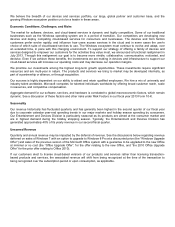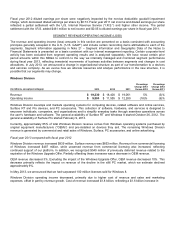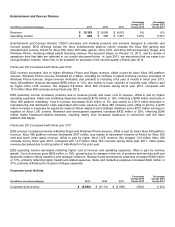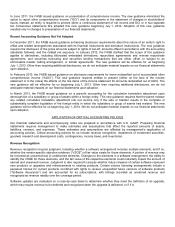Microsoft 2013 Annual Report Download - page 26
Download and view the complete annual report
Please find page 26 of the 2013 Microsoft annual report below. You can navigate through the pages in the report by either clicking on the pages listed below, or by using the keyword search tool below to find specific information within the annual report.
Certain corporate-level activity is not allocated to our segments, including costs of: broad-based sales and marketing;
product support services; human resources; legal; finance; information technology; corporate development and
procurement activities; research and development; costs of operating our retail stores; and legal settlements and
contingencies.
Fiscal year 2013 compared with fiscal year 2012
Corporate-level expenses increased, primarily due to higher legal charges from the European Commission fine of
€561 million (approximately $733 million) for failure to comply with our 2009 agreement to display a “Browser Choice
Screen” on Windows PCs where Internet Explorer is the default browser (the “EU fine”). Corporate-level expenses also
grew due to a $350 million increase in retail stores expenses and $287 million higher intellectual property licensing costs.
Fiscal year 2012 compared with fiscal year 2011
Corporate-level expenses increased due mainly to full year Puerto Rican excise taxes, higher headcount-related
expenses, and changes in foreign currency exchange rates. These increases were offset in part by lower legal charges,
which were $56 million in fiscal year 2012 compared with $332 million in fiscal year 2011.
COST OF REVENUE
Cost of Revenue
(In millions, except percentages)
2013
2012
2011
Percentage
Change 2013
Versus 2012
Percentage
Change
2012
Versus 2011
Cost of revenue
$ 20,249
$ 17,530
$ 15,577
16%
13%
As a percent of revenue
26%
24%
22%
2ppt
2ppt
Cost of revenue includes: manufacturing and distribution costs for products sold, including Xbox and Surface, and
programs licensed; operating costs related to product support service centers and product distribution centers; costs
incurred to include software on PCs sold by OEMs, to drive traffic to our websites, and to acquire online advertising space
(“traffic acquisition costs”); costs incurred to support and maintain internet-based products and services, including
datacenter costs and royalties; warranty costs; inventory valuation adjustments; costs associated with the delivery of
consulting services; and the amortization of capitalized research and development costs.
Fiscal year 2013 compared with fiscal year 2012
Cost of revenue increased, reflecting $1.6 billion in product costs associated with Surface and Windows 8, including a
charge for Surface RT inventory adjustments of approximately $900 million, $578 million higher headcount-related
expenses, a $375 million increase in expenses for payments to Nokia related to joint strategic initiatives, $287 million
higher intellectual property licensing costs, a $273 million increase in royalties on Xbox LIVE content, and a $152 million
increase in retail store expenses, offset in part by a $1.0 billion decrease in manufacturing and distribution costs
associated with lower volumes of Xbox 360 consoles sold and a $431 million decrease in traffic acquisition costs.
Fiscal year 2012 compared with fiscal year 2011
Cost of revenue increased reflecting higher headcount-related expenses, payments made to Nokia, and changes in the
mix of products and services sold. Headcount-related expenses increased 20%, primarily related to increased Enterprise
Services headcount.
























